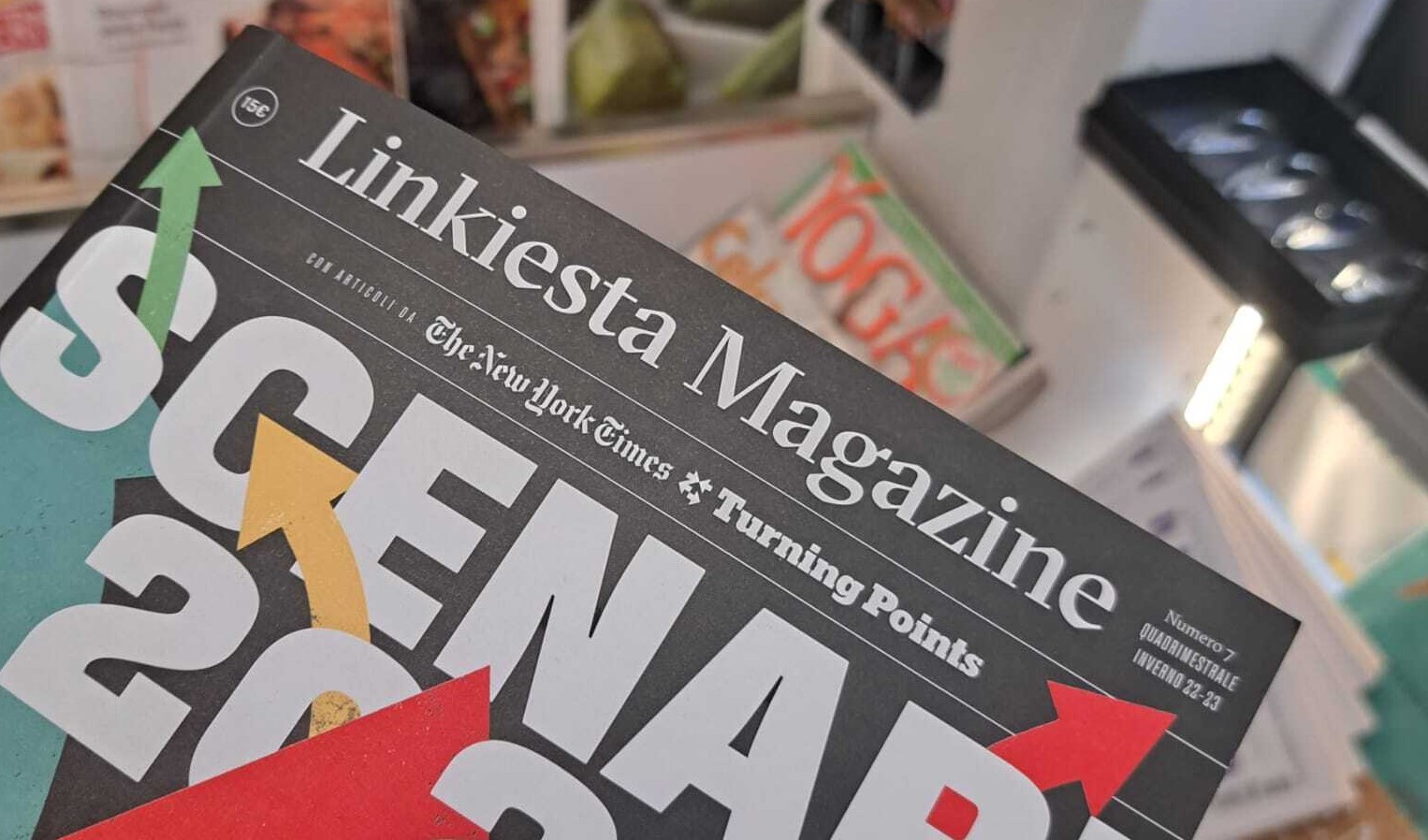In a tough environment for digital news, this Italian news site is betting on a rebrand

Linkiesta Magazine at one of Milan's newsagents. Credit: Jacopo Adami.
Linkiesta was among the first digital-born brands in Italy, a country whose news industry has been slower in shifting to digital than the ones of its Western neighbours.
When it launched in 2011, it was exclusively digital and it was an investigative outlet: its name merges a reference to the Internet (‘link’) with the Italian term for journalistic investigation (‘inchiesta’). Twelve years on, however, the outlet has turned into something different. After years of losses, the site undertook a transformation in 2019, dropping investigations altogether in favour of an array of projects including live events, sister publications and, perhaps surprisingly, print magazines.
How has this transformation affected Linkiesta’s bottom line? How have its readers reacted to these changes? And what consequences have they had for the publication and for the Italian media landscape as a whole? These are some of the issues I discussed with Linkiesta’s editor-in-chief Christian Rocca and with Alessio Cornia, an Italian academic researcher based in Dublin and the author of the Italian section of our Digital News Report.
How Italians get their news
Italian print media is experiencing a long-term slow decline, fuelled by the closure of traditional newsagents, 10% of which closed in the first six months of 2020. Digital news sources are still head-to-head with TV as the most popular way for Italians to access news. Both TV and digital were particularly close in popularity in the first year of COVID-19, but TV news viewership has seen a slight decline in the past year, according to our 2022 Digital News Report.
Italy is also seeing a recent burst of digital disruption, exemplified by the belated success of some of its original digital-born outlets and by the popularity of products of upstarts like Chora Media in the podcast and social media space. Linkiesta, however, is taking a different path after embarking on a new editorial strategy that has seen the newspaper redefine its identity and rethink its products in a bid to become profitable.
An early experiment
Linkiesta was founded in 2011 by a group of around 70 investors from outside the world of news, as an initiative driven by their ‘sense of civic duty’, according to current editor-in-chief Christian Rocca. The newspaper was exclusively digital, free to read and focused on financial investigations.
As the Internet became more relevant to the Italian news industry, legacy news brands like Repubblica and Corriere della Sera did very well online. “We had very successful online news providers, but they were the same news organisations that were already dominating the offline market,” said Alessio Cornia, Assistant Professor at Dublin City University and Research Associate at the Reuters Institute.
Linkiesta was among the first Italian digital-born news brands. It started its operations in the early 2010s along with Il Post, Fanpage and others. For all of these outlets, “there were many difficulties, especially for the first five to six years. All of them were basically all losing money,” Cornia explained.
One of these early digital-born news sites, Lettera43, closed down in May 2020, months before its tenth birthday. In a goodbye article, its founding editor Paolo Madron wrote: “Sadly, we never balanced our budget due to a cost structure that, even when progressively reduced, still turned out to be plethoric.”
Linkiesta struggled too. “Every year throughout the decade, shareholders invested money to support [Linkiesta] because they really believed in the newspaper,” Rocca said. This led to a trickle of investors leaving the project or reducing their shares. By 2019 less than a third of the initial number of investors were still involved. Five of them hold shares above 6%, including Rocca himself, who holds a 10% share.
A step change for new media
By 2021 some of the Italian digital-born news outlets had started to succeed. Facebook-born Fanpage, for example, obtained the widest online reach in the survey for our Digital News Report 2021. Il Post, a news site founded by journalist Luca Sofri, launched a membership scheme in 2019. By January 2022, 52% of its annual income came from the contributions of more than 50,000 paying members, according to the outlet’s 2021 balance sheet.
Linkiesta, however, is a different news product. It has a strong focus on politics and economics rather than gossip or entertainment as Fanpage does, something which makes it more difficult to expand its audience, Cornia explained. Moreover, unlike similar outlets, it does not have a paywall and isn’t actively attracting any paying members.
Linkiesta does have a scheme, called Linkiesta Club, where readers can sign up for a yearly fee in exchange for some Linkiesta paper products and privileged access to live events. Payment options range from €60 a year for students to €1,200 a year for the highest tier, called ‘benefactors’.
The option to join the club, however, hasn’t been developed or advertised much. At the moment Linkiesta only has around a thousand members, Rocca said.
“There’s a lot of work to do with readers. This could become a revenue stream that’s really ours, that doesn’t depend on external investors,” Rocca said, adding that it’s something he wants to start developing.
A change of direction
Rocca took over as editor-in-chief in October 2019. Before joining Linkiesta, he had worked at Italian newspapers Il Foglio and Il Sole 24 Ore as a correspondent and as a columnist. He soon started implementing changes to Linkiesta’s editorial and business strategies and launched an expansive array of projects.
The investigations that gave Linkiesta its name were left behind as the newspaper pivoted towards comment and analysis instead. Rocca says he took this step “to make Linkiesta into a player in Italian public political debate.” Now, the website has turned into a collection of opinion pages and columns, notably with no breaking news.
As Cornia writes on Italy’s country page of our 2022 Digital News report, digital-born disruptors in the country’s media often adopt a niche they feel is being neglected by established outlets. For Linkiesta’s new management, that niche was the political standpoint behind its opinion and analysis pieces.
“Newspapers have to have a soul. They have to have something to say. We picked a coherent group of political and cultural analysts, and this led us to find our own political space,” said Rocca, who argued this is particularly important for a small newspaper operating in the digital space.
Linkiesta is against populism from either end of the political spectrum. “Like many other countries, Italy experienced surges of left-wing and right-wing populism. We noticed that other newspapers would shift their position, depending on their affiliations. Right-wing newspapers are populist when right-wing parties are in opposition and pro-government when their preferred parties are in government. And the same would happen with the left-wing papers,” Rocca said.
Against ‘bipopulism’
Rocca and his colleagues very frequently use the term ‘bipopulism’ and discuss how to counter its influence in Italian politics in the paper. “This is fully in line with the routines and traditions within the Italian news market,” Cornia said, “They found a political niche that is not fully covered by other news outlets, and this niche can be labelled as ‘Terzo Polo’.”
Terzo Polo is a centrist, liberal, pro-EU political alliance. Its two main parties are Azione and Italia Viva, small break-away parties from the centre-left Democratic Party (PD). The group currently holds 21 out of 400 seats in Italy’s House of Representatives and nine out of 200 in the Senate.
Terzo Polo’s leaders, Carlo Calenda and Matteo Renzi, often use the term ‘bipopulism’, coined in Italy by journalist Massimo Giannini from Repubblica in 2018. The term is now used almost exclusively by Terzo Polo politicians in mainstream political debate, linguistics professor Michele Cortelazzo writes.
Calenda and Renzi were also among the speakers present at the most recent Linkiesta Festival, a two-day series of live events consisting of one-on-one and panel conversations moderated by Linkiesta journalists. Most of the politicians on the panels were associated with Azione-Italia Viva, and the focus of the conference was ‘the alternative to bipopulism’.
“It’s [Terzo Polo politicians] who follow us, we launched [discussions about] bipopulism and we wrote for months and months that they should unite and finally they did. This is our success,” Rocca said when asked about Linkiesta’s ideological proximity with the group.
The term ‘bipopulism’ was mentioned on Linkiesta twice in late 2019, before being picked up again in February 2021, after which it has appeared in articles on the site almost every day. Calenda’s tweets show a boom in the use of the word beginning in spring 2022.
Embracing print and holding a festival
Linkiesta Festival is just one of the ways Rocca has expanded Linkiesta’s presence beyond the internet. Today Linkiesta describes itself as a ‘digital, print and live newspaper which comments, analyses and delves into Italian and international news.’
The Festival is held once a year in November in Milan’s Franco Parenti Theatre, and lasts two days. It’s free to attend and raises money through sponsorships and through selling Linkiesta products throughout the event.
One of the most significant projects led by Rocca has been the creation of a print edition of Linkiesta. Called Linkiesta Magazine, it looks more like a coffee table book than a newspaper and is published three times a year: in January, June and November.
Linkiesta also collaborates with the New York Times, publishing its special projects Turning Points, The Big Ideas and World Review in Linkiesta Magazine, alongside Linkiesta’s own original content. “This has really raised our standing as an Italian editorial publication, and has also helped us with advertising,” Rocca said.
“Income for us comes mainly from three sources,” Rocca said. “One is print advertising, which pays much better than digital advertising. Another is events: the Festival and other talks for which we organise sponsorships on the model of The Atlantic Monthly and many other US publications; and the third is an agency we’ve set up that offers editorial and content services to companies.” These services include designing publications, creating content for websites, organising panels and events and producing podcasts on behalf of clients. Linkiesta also hosts sponsored content on its own channels.
Digital-born outlets turning to print isn’t unusual in Italy, Cornia said. As digital advertising isn’t particularly profitable, online media companies need to find other revenue streams to balance the books.
“Most news consumption is increasingly moving from offline to online. So the traditional offline advertising market is shrinking as well. But at this very moment, offline advertising is much more profitable for news publishers. So it's not the future or innovative, but it’s the most profitable,” Cornia said.
This is one of the reasons Rocca and his team began offering editorial services to companies. “Companies no longer need to communicate like they did in the 20th century, through media advertising,” Rocca said. “They communicate directly through their own sites. But if you sell petrol or offer financial services or make shirts, you don’t know how to communicate and you have to go to someone else. So a media company can become a hub for content that gets distributed on all available platforms, including platforms owned by the companies who need to communicate.”
The fact that Linkiesta produces so many different products helps Rocca’s team build more rounded relationships with advertisers. As well as Linkiesta’s main website and magazine, the outlet also started several sections linked to the main site, but that act as separate publications, some with their own print editions. They are Linkiesta eccetera, focused on arts, culture and lifestyle; Europea, focused on EU institutions; Gastronomika, focused on the culture and industry of food; Greenkiesta, focused on environmental issues; Il lavoro che verrà, focused on the future of work; and Slava Evropi, a news site publishing Europe-focused news and opinion in Ukrainian.
Gastronomika also has its own festival, with the first edition having taken place in October, and another one coming up in spring.
Slava Evropi, on the other hand, is among Linkiesta’s most recent initiatives, and is supported by the European Parliament. Some of the material is translated from Linkiesta’s Italian-language content, and some are original pieces commissioned especially for the site, such as explainers related to the European Union. These meet a need both for Ukrainian refugees living in other European countries and for a domestic Ukrainian audience interested in finding out more about the bloc following Ukraine’s application to join the EU, editor Yaryna Grusha Possamai said.
The bottom line
Linkiesta’s new direction and the projects spearheaded could be paying off: according to Rocca, the newspaper made a profit in 2021 for the first time in its 12-year history. This wasn’t a large profit: around €10,000. But for a company that had been haemorrhaging money for a decade, the balance felt like a small but significant victory.
Results for 2022 are not in yet. Rocca hopes for another good year: not enough to pay dividends, but enough to keep funding Linkiesta’s projects without asking the investors for more.
In every email we send you'll find original reporting, evidence-based insights, online seminars and readings curated from 100s of sources - all in 5 minutes.
- Twice a week
- More than 20,000 people receive it
- Unsubscribe any time






